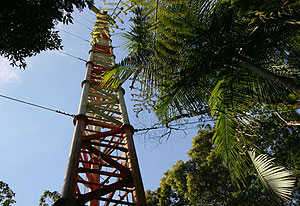SAO PAULO, Brazil — May 20, 2010 — The Amazon rainforest alone stores an amount of carbon equivalent to a decade of global fossil fuel emissions, and plays a crucial role in the world’s precipitation and oxygen-transfer processes — earning it the nickname, the “lungs of the world.” Because of its sheer size, changes in the forest affect not only the local environment, but global weather, by altering wind and ocean current patterns.
Understanding how those processes work on a small scale was the goal of the recent Brazilian Rainforest Sensor Network project — a joint effort from the University of Sao Paulo, Brazil, Johns Hopkins University, the São Paulo Research Foundation, the Brazilian National Institute for Space Research, and Microsoft Research.
It’s part of an effort to help scientists better understand the planet’s delicate and complex systems, and the impact of human activities. Rob Bernard, Microsoft’s chief environmental strategist, says that information technology is playing a key role in that quest. Microsoft is working on several fronts to help scientists understand and share environmental information, and demonstrate the potential of this research.
“With the world’s population expected to hit 9 billion people by 2040, all of us need to better understand our impact on the planet,” Bernard says. “In order to understand, we need to have better information and better ways to visualize that information.”

Arrayed through a network of towers over a hill slope, approximately 200 sensors designed by Microsoft Research were painstakingly deployed by the research team in the heart of the rainforest.
In 2009, scientists from the groups working on the Amazon project converged in Mata Atlântica, the Atlantic coastal rainforest in the state of São Paulo, southeast Brazil, to develop, build, test and deploy a wireless sensor network for collecting environmental data.
Program Manager Rob Fatland of Microsoft Research’s External Research division was brought onboard the project for his expertise in deploying sensor networks into rugged environments.
For the past few years, Fatland has spent summers in Juneau, Alaska, working on sensors to measure the flow of runoff from the Lemon Glacier, part of Juneau’s famed 1,500-square-mile ice field. He says studies such as these are vital pieces of the puzzle that can help scientists understand much larger issues.
“This research operates on scales of meters and minutes, but has implications all the way up to climate models spanning the earth over decades,” says Fatland. “The data will help researchers visualize how the rainforest connects with the earth’s atmosphere, which is important for our understanding of climate change.”
The sensors used in the project were designed by Microsoft Research to handle the extreme conditions in the rainforest, measuring temperature, water vapor and solar radiation. Arrayed through a network of towers over a hill slope, the approximately 200-sensor network was painstakingly deployed by the research team in the heart of the rainforest.
Fatland says the efficiency of sensor networks in harvesting usable data is one of the big advantages of this approach. As opposed to a traditional meteorology station, which measures wind, temperature and humidity at one location, the sensor network provides a continuous, three-dimensional look at the forest’s weather dynamics.
“Sensor networks are distributed across extended terrain and so they open up an entirely new scope of applications,” Fatland says. “Another critical feature of this technology is that it has a very light footprint. It can be installed using fairly nonintrusive methods, and as a result, we do not impact the environment we are trying to observe.”
Eventually the project could serve as a blueprint, not just for rainforests but other harsh environments such as the ocean floor, the desert or polar ice fields. Sensor networks are already being applied to agriculture, where they measure irrigation levels. Similar methods have even been used to triangulate the calls of birds and animals to observe their behavioral patterns. But the success rate Microsoft and Johns Hopkins were able to achieve in the rainforest paves the way for using sensors in new ways.
“This project is an example of Microsoft Research’s commitment to collaboration with the academic community on environmental problems, and our dedication to make technical solutions openly available to any researcher who could benefit from the project results,” says Fatland. “From the success of this pilot study we are enthusiastic to expand to a larger study, perhaps in Amazonia, which scales upward by a factor of ten or more.”
It may seem tangential for Microsoft, but according to Bernard, an important part of the company’s work is the ability to bring technology and technologists to help people and organizations understand the environment and our impact upon it. The work scientists are doing can provide the foundation for advancements in energy usage, resource management, environmental planning and policy decisions. And technology can help accelerate and improve this work.




